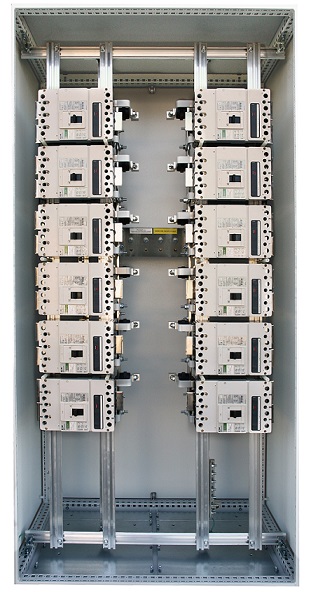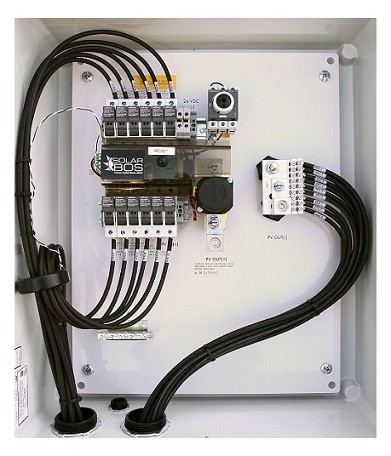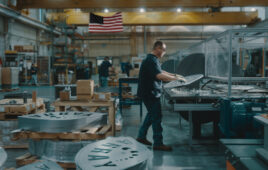 The role of the combiner box is to bring the output of several solar strings together. Daniel Sherwood, director of product management at SolarBOS, explained that each string conductor lands on a fuse terminal and the output of the fused inputs are combined onto a single conductor that connects the box to the inverter. “This is a combiner box at its most basic, but once you have one in your solar project, there are additional features typically integrated into the box,” he said. Disconnect switches, monitoring equipment and remote rapid shutdown devices are examples of additional equipment.
The role of the combiner box is to bring the output of several solar strings together. Daniel Sherwood, director of product management at SolarBOS, explained that each string conductor lands on a fuse terminal and the output of the fused inputs are combined onto a single conductor that connects the box to the inverter. “This is a combiner box at its most basic, but once you have one in your solar project, there are additional features typically integrated into the box,” he said. Disconnect switches, monitoring equipment and remote rapid shutdown devices are examples of additional equipment.
Solar combiner boxes also consolidate incoming power into one main feed that distributes to a solar inverter, added Patrick Kane, product manager at Eaton. This saves labor and material costs through wire reductions. “Solar combiner boxes are engineered to provide overcurrent and overvoltage protection to enhance inverter protection and reliability,” he said.
“If a project only has two or three strings, like a typical home, a combiner box isn’t required. Rather, you’ll attach the string directly to an inverter,” Sherwood said. “It is only for larger projects, anywhere from four to 4,000 strings that combiner boxes become necessary.” However, combiner boxes can have advantages in projects of all sizes. In residential applications, combiner boxes can bring a small number of strings to a central location for easy installation, disconnect and maintenance. In commercial applications, differently sized combiner boxes are often used to capture power from unorthodox layouts of varying building types. For utility-scale projects, combiner boxes allow site designers to maximize power and reduce material and labor costs by distributing the combined connections.
The combiner box should reside between the solar modules and inverter. When optimally positioned in the array, it can limit power loss. Position can also be important to price. “Location is highly important because a combiner in a non-optimal location may potentially increase DC BOS costs from losses in voltage and power,” Kane explained. “It only constitutes a few cents per watt, but it’s important to get right,” Sherwood agreed.
Little maintenance is required for combiner boxes. “The environment and frequency of use should determine the levels of maintenance,” Kane explained. “It is a good idea to inspect them periodically for leaks or loose connections, but if a combiner box is installed properly it should continue to function for the lifetime of the solar project,” Sherwood added.
 The quality of the combiner box is the most important consideration when selecting one, especially since it’s the first piece of equipment connected to the output of the solar modules. “Combiner boxes are not expensive compared to other equipment in a solar project, but a faulty combiner box can fail in a dramatic way, involving shooting flames and smoke,” Sherwood warned. “All should be third-party certified to conform to UL1741, the relevant standard for this type of equipment,” Sherwood said. Also be sure to pick a combiner box that meets the technical requirements for your project.
The quality of the combiner box is the most important consideration when selecting one, especially since it’s the first piece of equipment connected to the output of the solar modules. “Combiner boxes are not expensive compared to other equipment in a solar project, but a faulty combiner box can fail in a dramatic way, involving shooting flames and smoke,” Sherwood warned. “All should be third-party certified to conform to UL1741, the relevant standard for this type of equipment,” Sherwood said. Also be sure to pick a combiner box that meets the technical requirements for your project.
A new trend is the incorporation of a whip: a length of wire with a solar connector on the end. “Rather than a contractor drilling holes in the combiner box and installing fittings in the field, we install whips at the factory that allow the installer to simply connect the output conductors to the box using a mating solar connector,” Sherwood explained. “It’s as easy as plugging in a toaster.”
This year arc-fault protection and remote rapid shutdown devices are more popular than ever, due to recent changes in the National Electrical Code that require them in many solar applications. “New technologies and components are driven by the NEC changes, as well as the desire for enhanced energy efficiency and reduction of labor costs,” Kane said. Some of these new components include: higher voltage components, integral mounting hardware and custom grounding options.




Is it compulsory to use combiner boxes for solar PV installation with 4 strings in the UK ?
Would it be ok to use a diode in series with each panel to prevent back feeding and a fuse on each panel to open that panel if a problem existed…
I need to replace the roofing under my Solar combiner box (but not the roofing under the panels). How can I temporarily disconnect the box without getting zapped? The DC voltage flows from this box to the Photovoltaic switch in the cellar and enters the inverter and then the AC current flows thru an external General Duty Safety Switch then back into the cellar to the general house power circuits.
do it at night lol
I have 12 solar panels I want to daisy chain them together to one wire would I still need one of these combiner boxes.from the picture the same amount of wires going into the box looks like it’s coming out of the box so where is the single wire that goes to the inverter controller? The inverter controllers only have one screw inlet for for the wire to come in to control the power how does that work when you have a 12 wires that you have to combine together
When combiner boxes do fail what are the causes? Is it just simple insulation breakdown or does the device have more complex failure modes?
“… connects the box to the inverter” ??
Should connect to the Controller.
Inverters being used nowadays have their own MPPT controllers built-in. I rarely see installations with a combiner box using the old inverters that necessitated a separate controller.
Can someone explain why the circuit protection devices are needed? Solar panels are made to run at or close to short circuit all the time so it can’t be protecting them. The charge controller or inverter is sized to handle 25% more than the solar panels can output in short circuit (per NEC code) so the circuit breakers are not protecting them. Circuit breakers are not fast enough to protect humans. You would need a GFCI breaker for that so they are not protecting humans. The wires are sized with higher ampacity than the short circuit current per NEC code so not protecting the wires. Not protecting the solar panels, charge controllers, inverters, wires, or humans. What are they for?
If you have a ground fault in one string circuit, without the fuses in the combiner box all the other string circuits would also backfeed current into the ground fault. So, assuming an Isc of 40A and 12 strings per combiner box, there would be 480A feeding that ground fault, not just 40A.
is a ground fault a short to ground, within that string of panels?
Ummmmmm….I’m not an expert on Solar Installations, but I have a 40year career history in Electronics and Theory. I’m leaning on “Confuse Solar Guy”‘s comment. If you have a diode in series on each string, and one string is shorted to ground (ground fault ???) then the voltage across that series string will be around 0v, but with max “Isc”. The Anode voltage of that diode will be lower than the Cathode, and will block current flowing from other strings into this “problem string”. Are you saying that your “Combiner Box” doesn’t have backfeed diodes in each string ???
would this go between the battery bank and inverter or between the panels and battery bank?
I would have thought it locates as close to array as possible, if overloading or short-circuit it shut down to protect wiring all the way from the field to the Inverter.
The solar charger sits between the panels and a battery bank. The combiner goes between the panel strings and the charger in an off grid system. While it is called a combiner, it may not actually combine strings in a smaller installation and is there as a disconnect and safety measure providing ground-fault protection and also arc-fault protection with the right kind of circuit breaker in place.
So if i have 3 solar string all facing in different E,Nth,W direction can i use a combiner box?Back to the House inverter?
Generally you wouldn’t want to do that. You would want to terminate each string into its own charge controller ( MPTT ) and you should have an inverter that has three MPTT inputs, one for each of your strings. You could save wiring with a combiner but lose performance in terms of energy harvested from each string by not allowing each string to be optimally handles by its own charge controller. If all of the strings faced the same way and were guaranteed to be shade free it would be an option.
Well it seems like what you would want is a disconnect and ground fault/arc fault safety device on each string and that would go in a box that might be called a “combiner box”. So there is no consolidation of wiring but other features that combiner boxes can provide are found in there.
You want something that protects the wiring and allows you to shut off your panels when you need to work on the charger or inverter. You also want something that will cause a shut off so that you don’t get electrocuted by a ground fault or set the house on fire with an arc fault.
I have just installed a solar system ,5 string combiner box linked to a 5 kva inverter.
The installer installed/fitted the combiner box on the roof.
Is it advisable as my logic tells me it is better fitted indoors out of the weather elements.
Kindly advise.
Combiner boxes typically have the same outdoor-ratings as inverters and are commonly installed outdoors. There should not be anything to worry about.
NEC rule is that the combiner box must be within 10 feet from the panel array.
NEC rule is that the combiner box must be within 10 feet from the panel array.
Can someone answer this!
Thank you
Richard
Would a typical (outdoor rated 480V 3-phase) breaker panel work as well as a combiner panel (for a ground mount system)?
If not, why not?
Thanks.
tengo un sistema de 28 paneles (7 kwp) y tengo que conectar a traves de un combiner box a un controlador de baterias pero el controlador de bateria tiene 4 entradas con vdc max de 175 volts/cu y Imax de 30 amps. Como puedo conectar las cadenas para alimentar el combiner box???
What if my system is strictly DC without any inverters? Is a combiner box still recommended? I’m putting a string of 3 panels of maximum 20VDC in series for 60VDC.. and combining 5 strings (15 panels) in parallel to feed into a battery management system .. the battery feeds a DC motor controller. Is there a risk in just wiring the 3Series 5Parallel panels directly into the battery management system if there is no inverter in the entire system? Thank you!
if you can feed your BMS directly without any inverter, I think you must consider putting a protection device. Every electricity connected to the sources needs to be protected with protection devices like DC Surge Protection Devices (SPD) or surge arrester. Both inverter or combiner includes protection so if you put it on your BMS then it will be a good investment. Wish it can help!
Does an MPPT controller considered as a protection?
what is the root cause for minimum value of currents when compared to the others ,even when i check the voltage that will shows as same as the remaining,and also i checked fuses they are also good.so what is the reason for this problem and how can i solve?
Hey Srinivas, the reason could be intensity mismatch or partial shading on one array (or one panel in a particular array).
When there is partial shading, the particular panel produces less current while the voltage almost remains unaffected (because the current is directly proportional to intensity while voltage is logarithmically related intensity)
what if one string has a higher voltage and lower amps than another string?
what if one string fails to generate voltage
does voltage flow from working or generating to non generating
what about the lightning arresters are the provided to send notification for any abnormality
When you select inverter, go for the one comes with itself SPD then you don’t have to worry about lightning arresters, of course if you fit SPD to the combiner it is safer.
Voltage does not flow between PV strings, it only flows to the Inverter.
Sir lets say one string has generation(voltage) and other string has no generation(no voltage). Then in this case what is there to ensure that current does not flow from one string to another.
For parallel strings, in case one string fails (we call this bad string) to generate output current, there is reverse current flow from the good string/s to the bad string. To prevent this, we install blocking diode at the end of each string. The blocking diodes are installed on a heat sink inside the combiner box.